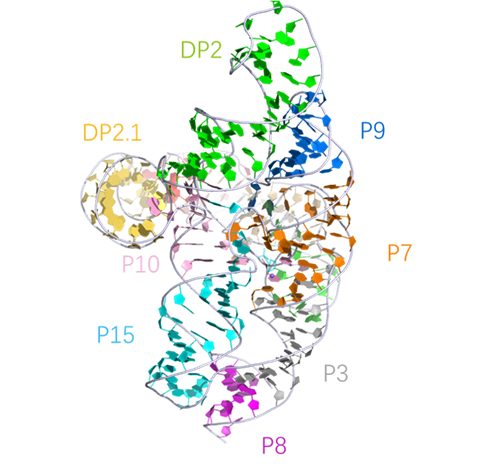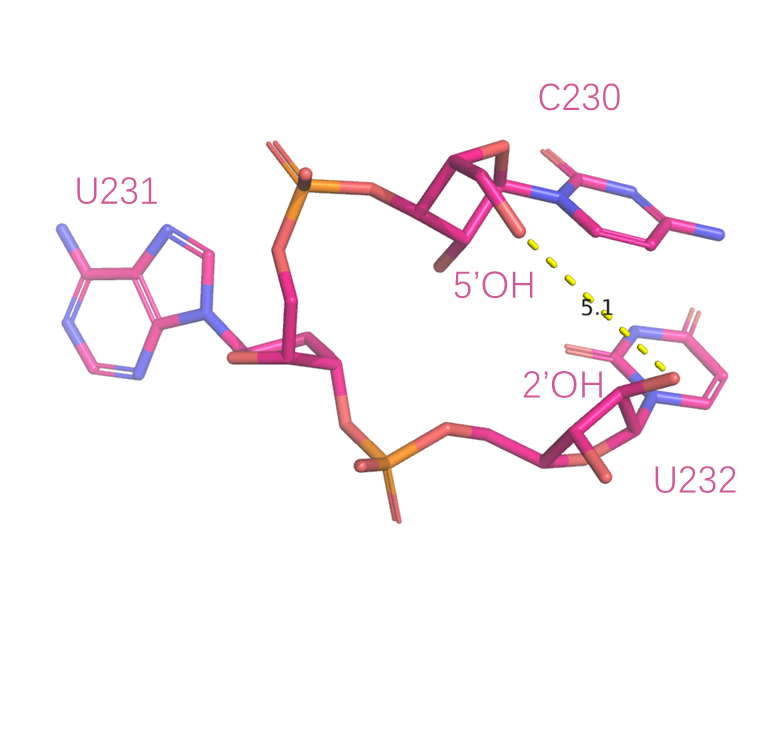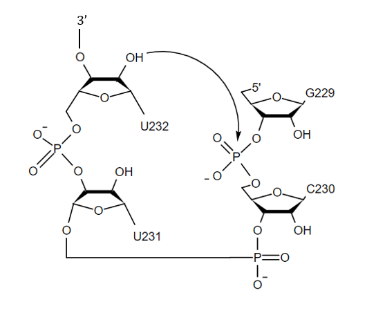Lariat-capping ribozyme
Rfam ID: RF01807
click into different sections:
Timeline
-
1994 Sequence discovered[1]
-
1995 Catalytic RNA element renamed as the group I-like ribozyme, GIR1[2]
-
2005 GIR1 makes tiny lariats[5]
-
2008 Molecular modelling of the GIR1 branching ribozyme[6]
-
2014 Crystal structures of the precleavage and postcleavage lariat-capping ribozymes[7]
-
2017 Lariat capping as a tool to manipulate the 5' end of mRNA[9]
Description
The Lariat capping ribozyme is a ~180 nt ribozyme with an apparent resemblance to a group I ribozyme. It is found within a complex type of group I introns, also termed twin-ribozyme introns. It catalyses a branching reaction in which the 2'OH of an internal residue is involved in a nucleophilic attack at a nearby phosphodiester bond.
Structure and mechanism
2D representation
Secondary structure diagrams of the active form of the DirLC ribozyme.

|
3D visualisation
The crystal structure of DirLCrz. This structure is represented according to the orientation used for group I intron ribozymes with P9 in the upper right corner and P15 (corresponding to P1 and P2 in group I intron ribozymes)
 |
|
Catalytic centre
The structure represents a post-cleavage situation with a distance of 5.1 Å from the nucleophilic O2'group of U232 to the 5' OH group (the phosphate is lacking in the construct). The presence of an iridium hexamine ion in the vicinity of the lariat fold could indicate the involvement of a metal ion site in catalysis.
 |
 |
References
[1] An intron in the nuclear ribosomal DNA of Didymium iridis codes for a group I ribozyme and a novel ribozyme that cooperate in self-splicing.
Johansen, S. and V. M. Vogt
Cell 76(4): 725-734.(1994)
[2] Two group I ribozymes with different functions in a nuclear rDNA intron.
Decatur, W. A., C. Einvik, S. Johansen and V. M. Vogt
EMBO J 14(18): 4558-4568.(1995)
[3] DiGIR1 and NaGIR1: naturally occurring group I-like ribozymes with unique core organization and evolved biological role.
Johansen, S., C. Einvik and H. Nielsen
Biochimie 84(9): 905-912.(2002)
[4] The group I-like ribozyme DiGIR1 mediates alternative processing of pre-rRNA transcripts in Didymium iridis.
Vader, A., S. Johansen and H. Nielsen
Eur J Biochem 269(23): 5804-5812.(2002)
[5] An mRNA is capped by a 2', 5' lariat catalyzed by a group I-like ribozyme.
Nielsen, H., E. Westhof and S. Johansen
Science 309(5740): 1584-1587.(2005)
[6] Molecular modelling of the GIR1 branching ribozyme gives new insight into evolution of structurally related ribozymes.
eckert, B., H. Nielsen, C. Einvik, S. D. Johansen, E. Westhof and B. Masquida
EMBO J 27(4): 667-678.(2008)
[7] Speciation of a group I intron into a lariat capping ribozyme.
Meyer, M., H. Nielsen, V. Olieric, P. Roblin, S. D. Johansen, E. Westhof and B. Masquida
Proc Natl Acad Sci U S A 111(21): 7659-7664.(2014)
[8] Molecular characterization of a new member of the lariat capping twin-ribozyme introns.
Tang, Y., H. Nielsen, B. Masquida, P. P. Gardner and S. D. Johansen
Mob DNA 5: 25.(2014)
[9] Lariat capping as a tool to manipulate the 5' end of individual yeast mRNA species in vivo.
Krogh, N., M. Pietschmann, M. Schmid, T. H. Jensen and H. Nielsen
RNA 23(5): 683-695.(2017)
[10] Use of a Lariat Capping Ribozyme to Study Cap Function In Vivo.
Pietschmann, M., G. Tempel, M. Halladjian, N. Krogh and H. Nielsen
Methods Mol Biol 2167: 271-285.(2021)
 Home
Home Database
Database Research
Research About us
About us

